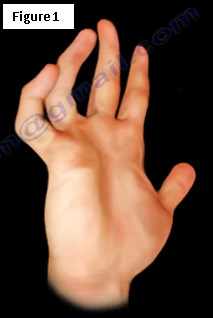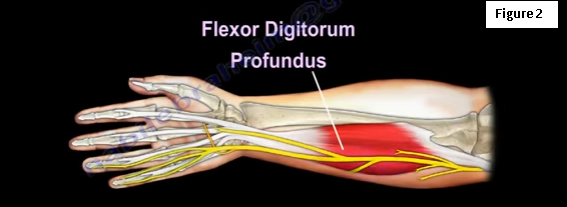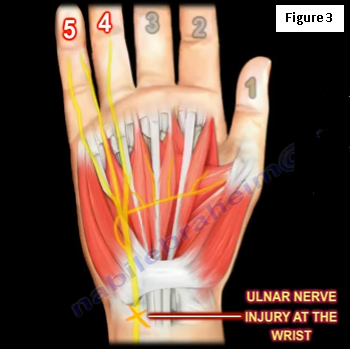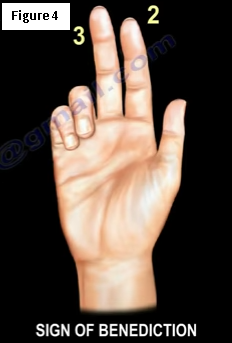Ulnar claw hand is an abnormal hand position that develops due to injury of the ulnar nerve. The ulnar claw hand deformity occurs more with a lower ulnar nerve lesion (below the elbow) and typically causes flexion and clawing of the fourth and fifth fingers due to the unopposed action of the medial part (ulnar part) of the flexor digitorum profundus muscle. Clawing is determined when the patient is asked to extend the fingers. A hand in the ulnar claw position will have the fourth and fifth fingers extended at the metacarpophalangeal (MCP) joints and flexed at the interphalangeal (IP) joints. When you ask the patient to extend the fingers, the patient will not be able to extend the interphalangeal (IP) joints at the fourth and fifth fingers (Figure 1).

This happens when the ulnar nerve innervates the ulnar half of the flexor digitorum profundus muscle. The ulnar nerve also innervates the third and fourth lumbrical muscles, all of the interosseous muscles, the adductor pollicis muscle. And the deep head of the flexor pollicis brevis. When there is an injury to the ulnar never at the wrist, there will be loss of function for all the interosseous muscles and the ulnar two lumbricals. The second and third digits are mainly unaffected by this injury except in adduction and abduction of the fingers, while the fourth and fifth digits are largely affected by injury to the ulnar nerve. With dysfuntion of these muscles, the extensor digitorum is unopposed, causing hyperextension of the fourth and fifth digits at the metacarpophalangeal (MCP) joints. The extensor digitorum is very affective in extending the MCP joint. The extensor digitorum gets help from the interossei and the lumbricals to extend the IP joints through the extensor hood or the extensor expansion. At the interphalangeal (IP) joints, the extensor digitorum has to overcome and counteract the flexion force that is exerted by the functional flexor digitorum profundus. (Figure 2)

The extensor digitorum cannot do this because there is no assistance from the lumbricals or the interossei muscles (clawing of the fingers will show up). This is usually a distal ulnar nerve lesion that perseveres innervation to the medial half (ulnar half) of the FDP muscle. In this distal lesion, the sensation at the dorsum of the fourth and fifth fingers will be intact because the dorsal sensory nerve may be spared if the lesion is at the wrist. There will definitely be numbness of the fourth and fifth fingers on the volar aspect. You may find wasting of the first interosseous muscle, and there may also be flattening of the hypothenar eminence. The fourth and fifth fingers will be stuck in a position of hyperextension at the MCP joints and flexion at the IP joints.
If lesion of the ulnar nerve is high and the flexor digitorum profundus is not working, then there will be no clawing of the fingers. In a high ulnar nerve lesion, there will be loss of sensation in the dorsal aspect of the fourth and fifth fingers. (Figure 3)

A differential diagnosis of Ulnar Claw Hand are Volkmann’s ischemic Contracture, Dupuytren’s Contracture, Spastic Hand, and Congenital Flexion Contracture (camptodactyly). While Claw Hand and The Sign of Benediction appear similar, they are not the same!
Claw hand occurs due to an ulnar nerve injury, usually a distal lesion. The fourth and fifth digits are flexed and the patient cannot straighten these two fingers. The Sign of Benediction usually occurs due to a median nerve injury, usually a high median nerve injury or anterior interosseous nerve lesion. The Sign of Benediction is the hand position that occurs when you ask the patient to make a fist and the second and third fingers will remain extended. When you ask the patient to extend the fingers, they will not be able to extend them. They cannot flex the second and third digits and also cannot do the “O.K. sign” (Figure 4). This is a median nerve or anterior interosseous nerve injury.

For more information on hand injuries, follow the links below:
For more information visit my YouTube channel:
